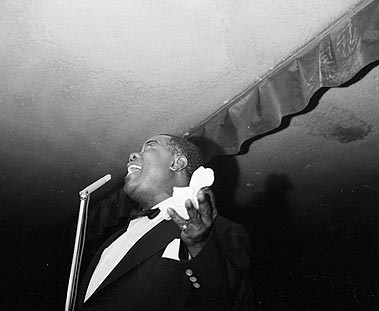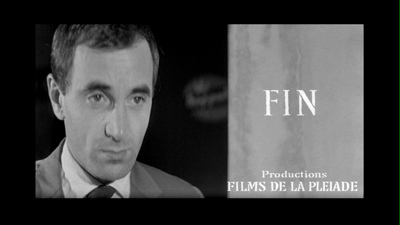 FRIDAY I drove out to Queens College with Ariel Davis, my research assistant, and spent the day at the Louis Armstrong Archives. We’re putting together the photo insert for Rhythm Man: A Life of Louis Armstrong, so we looked through box after box of prints, publicity stills, contact sheets, and one-of-a-kind snapshots. I’d already tracked down a wonderful photograph by Weegee of Armstrong on stage in 1940 that I’m thinking of using on the dust jacket.
FRIDAY I drove out to Queens College with Ariel Davis, my research assistant, and spent the day at the Louis Armstrong Archives. We’re putting together the photo insert for Rhythm Man: A Life of Louis Armstrong, so we looked through box after box of prints, publicity stills, contact sheets, and one-of-a-kind snapshots. I’d already tracked down a wonderful photograph by Weegee of Armstrong on stage in 1940 that I’m thinking of using on the dust jacket.
At day’s end Ariel guessed that we’d gone through some two thousand photos, which seemed a bit high but not implausible. It certainly felt as though we had. Fortunately, Satchmo was as photogenic as it’s possible for a human being to be, and we brought home copies of thirty-five choice images, many of them previously unpublished.
SATURDAY I was supposed to meet Mrs. T in Fairfield, Connecticut, at a surprise birthday party for a friend, but Tropical Storm Hanna got in the way, so I stayed home and spent the afternoon and evening putting one last coat of polish on the final draft of Rhythm Man. It was three in the morning by the time I was finished.
This is the last paragraph of the afterword:
I thank my mother, who called me into the living room of our Missouri home one Sunday night and sat me down in front of the TV, on which Louis Armstrong was singing “Hello, Dolly!” on The Ed Sullivan Show. “This man won’t be around forever,” she said. “Someday you’ll be glad you saw him.” That was back when the public schools in my home town were still segregated, two decades after a black man had been dragged from our city jail, hauled through the streets at the end of a rope, and set afire. Yet even in a place where such a monstrous evil had been wrought, my mother came to love Armstrong–and, just as important, to respect him–not merely for the beauty of the music he made but also for the goodness of the man who made it. I wrote this book so that she, and others like her, might know more about the man they loved.
SUNDAY Don’t ever try to finish a primary-source biography and an opera libretto at the same time! I got up at eight and put in four uninterrupted hours of work on The Letter. I had a few tiny kinks to straighten out before we send the revised piano-vocal score off to Subito Music, Paul Moravec‘s publisher. Most were passages written in haste with which I’d never been fully satisfied, and it was a relief to get them fixed at last.
 As soon as I was done, I threw on my clothes, caught a cab, and headed downtown to Film Forum to look at a new print of François Truffaut’s Shoot the Piano Player, which I last saw a couple of decades ago. Since then I’ve read David Goodis’ Down There, the pulp novel on which Truffaut’s 1960 film was based. I like Down There, but it’s one of the most humorless books ever written, a exercise in nihilistic despair. Not so Shoot the Piano Player, which infuses Goodis’ grim plot with fey touches of romance and frivolity that make the final disaster all the more terrible by contrast.
As soon as I was done, I threw on my clothes, caught a cab, and headed downtown to Film Forum to look at a new print of François Truffaut’s Shoot the Piano Player, which I last saw a couple of decades ago. Since then I’ve read David Goodis’ Down There, the pulp novel on which Truffaut’s 1960 film was based. I like Down There, but it’s one of the most humorless books ever written, a exercise in nihilistic despair. Not so Shoot the Piano Player, which infuses Goodis’ grim plot with fey touches of romance and frivolity that make the final disaster all the more terrible by contrast.
David Thomson, my favorite film critic, included Shoot the Piano Player in “Have You Seen…?”: A Personal Introduction to 1,000 Films. As always, his comments are very much to the point:
The speed with which asides and inserts could come and go, and the electric shift in mood from romantic to absurd, from lyrical to tragic–those things are still models for any filmmaker and a sign of how quickly film can work (this is a complicated movie of only 80 minutes). Marie Dubois is warm, Nicole Berger haunting, and the gangsters are so funny and yet so alarming. I find an extraordinary nostalgia in the mere sound of [Georges] Delerue’s music–and something just as compelling in the young man’s amazed rapture at finding he could do anything with film.
Me, too, and I also reveled in seeing a classic film in a theater for the first time in…well, I don’t know how long. I remember when I used to go to Film Forum once or twice a month to see old movies, but now I stay home, send out for pizza, curl up on my couch, and watch them on TV, sometimes with Mrs. T or a friend and sometimes by myself.
Thomson has this to say about home moviegoing in “Have You Seen…?”:
I see fewer films in real dark, in great prints, on enormous screens. I watch the videos on television, and try to adjust to the diminution….I lament the loss, but know that everything in the business and in the treatment of movies is shifting toward small-screen study. Otherwise sensible people write Ph.D. theses on particular movies without ever seeing them on a large screen. And if their writing is a little dry, or a little short of what I recall as magical effects, well, the Ph.D. is a professional achievement. Is it possible that the movies are going to end up as museum pieces–like the way we now study old newspapers? We should remember that the “meaning” of newspaper content had to do not just with the “news” preserved but with the dailiness of the paper, its feel in the hands, its smell, and its illusion of opening up the grubby world.
As for me, I loved seeing Shoot the Piano Player surrounded by silent, enthralled people huddled together in a darkened room. The experience was a miniature vacation, a present that I gave myself as a reward for the successful completion of two pieces of hard labor and a month and a half of theater-related travel. Now I wish I could take a whole week off and do nothing but go to the movies.
No such luck, of course–duty calls–but at least I was able to remind myself of what I’ve been missing.
